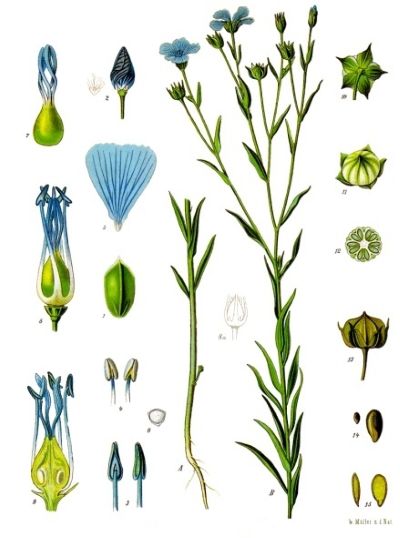Common Flax
Common Flax
Linum usitatissimum L.
Linaceae Family
Description of Flax
Common flax is an annual herbaceous plant 30–120 cm tall. Root system taproot, penetrating to 40–100 cm depth. Stem straight, thin, slightly branched at the top. Leaves alternate, narrow, lanceolate, 2–5 cm long, gray-green. Flowers blue or white, 1.5–2.5 cm in diameter, with five petals, gathered in loose inflorescences. Fruits spherical capsules, 6–8 mm, containing 6–10 shiny brown seeds (flaxseed). Flowering in June–July, fruiting in July–August. Propagated by seeds. Varieties: ‘Mogilevsky’, ‘Svetly’, ‘Dashkovsky’ (oilseed); ‘L-1120’, ‘Tomsky’ (fiber).
Distribution and Ecology of Flax
Common flax originates from the Mediterranean and Western Asia, cultivated in temperate regions (Russia, Canada, China, Europe). Prefers loose, fertile soils (pH 6.0–7.0), well-lit areas. Optimal growth temperature 15–25 °C, withstands short frosts to -5 °C. Seed yield: 0.5–2 t/ha, fiber: 0.3–1 t/ha. Care: watering (10–15 L/m² every 7–10 days), feeding with nitrogen and phosphorus fertilizers (15–20 g/m²), protection from flax flea beetle and fungal diseases. Propagated by seeds (sowing in April–May). Ecologically improves soil in crop rotation (3–4 years). Not invasive.
Raw Materials from Flax
Raw materials: seeds, flaxseed oil, fiber, rarely stems and leaves. Seeds harvested in July–August after capsule ripening, dried at 30–35 °C (yield 20–25%). Flaxseed oil extracted by cold pressing (yield 30–40%). Fiber obtained from stems after soaking and drying (yield 15–20%). Leaves harvested in June, dried in shade (yield 10–15%). Quality: seeds brown, shiny, moisture <12%, organic/mineral impurities ≤0.5%, total ash ≤5%; oil clear, yellowish; fiber light, mold-free. Store seeds and fiber in dry containers (2–3 years), oil in dark bottles at 0–5 °C (6–12 months). Seeds aroma weak, nutty; taste oily.
Chemical Composition of Flax
Seeds: fatty oil (30–45%, omega-3, omega-6), proteins (18–20%), carbohydrates (20–25%), lignans (0.7–1.5%), fiber (25–30%), vitamins (B1, B6, E), minerals (magnesium, potassium, phosphorus). Flaxseed oil: alpha-linolenic acid (50–60%), linoleic acid, oleic acid. Leaves: flavonoids, tannins (2–3%), vitamin C (up to 20 mg/100 g). Fiber: cellulose (70–80%). Calorie content of seeds: 500–550 kcal/100 g, oil: 900 kcal/100 g.
Effects and Applications of Flax
Flax has anti-inflammatory, enveloping, laxative, antioxidant, and hypocholesterolemic effects due to omega-3 acids, lignans, and fiber. Seeds used for constipation, gastritis, stomach ulcers, cholesterol reduction, heart and vessel support. Flaxseed oil improves metabolism, strengthens immunity, used for atherosclerosis and skin diseases. Seed infusions have enveloping effects, used for cough and mucous inflammations. Leaves (infusions) used for skin irritations. In cosmetology, oil and seeds moisturize skin, strengthen hair. Externally, oil used for wound and burn healing.
Precautions for Using Flax
Seeds in large quantities (>30 g/day) may cause diarrhea or bloating due to fiber. Flaxseed oil (>30 ml/day) may cause nausea or allergic reactions. Store seeds at humidity <12% and oil at 0–5 °C to prevent oxidation. Give children under 3 years infusions in doses ≤5 ml/day. Seeds require plenty of water (≥200 ml per 10 g) to prevent intestinal obstruction. Do not combine with anticoagulants or hormonal drugs without doctor's consultation. External oil application requires allergy test.
Contraindications for Using Flax
Flax contraindicated in allergies to Linaceae, intestinal obstruction, acute pancreatitis, cholelithiasis, pregnancy, lactation, children under 1 year. External oil use prohibited in eczema, psoriasis, or open wounds.
Recipes with Flax
- Seed Infusion for Constipation. Pour 10 g seeds with 200 ml boiling water, infuse 30 min, drink 100 ml 1 time a day, 7 days.
- Seed Decoction for Cough. Boil 10 g seeds in 200 ml water 10 min, drink 50 ml 2 times a day, 5 days.
- Leaf Infusion for Skin. Pour 10 g leaves with 200 ml boiling water, infuse 20 min, wipe skin 2 times a day, 7 days.
- Oil for Atherosclerosis. Take 10 ml flaxseed oil in the morning on empty stomach, 30 days.
- Paste for Wound Healing. Mix 10 g ground seeds with 10 ml water, apply to skin for 20 min, rinse, 5 days.
Cosmetics from Flax
Flaxseed oil and seeds used in cosmetology due to moisturizing, anti-inflammatory, and nourishing properties, improve skin and hair condition.
- Face Mask. Mix 10 ml flaxseed oil with 10 g honey, apply to face for 15 min, rinse. Use 1 time a week.
- Body Scrub. Mix 10 g ground seeds with 10 ml coconut oil, massage skin 5 min, rinse. Use 1 time a week.
- Hair Mask. Apply 10 ml flaxseed oil to hair roots, rinse after 30 min, 1 time a week.
- Skin Toner. Infuse 10 g seeds in 200 ml boiling water 30 min, wipe face 1 time a day, 7 days.
Culinary Uses of Flax
Flax seeds used in baking, porridges, salads, smoothies. Oil added to salads and cold dishes. Store seeds at 0–5 °C up to 2 years, oil up to 6 months. Varieties: ‘Mogilevsky’ (oilseed), ‘L-1120’ (fiber).
- Smoothie with Flax. Mix 10 g seeds with 200 g berries, 100 ml yogurt, blend, serve chilled.
- Bread with Flax. Add 20 g seeds to dough (300 g flour, 10 g yeast, 200 ml water), bake at 200 °C 30 min.
- Salad with Flax Oil. Mix 10 ml oil with 100 g vegetables, 5 ml lemon juice, serve fresh.
- Porridge with Flax. Add 10 g ground seeds to 100 g oatmeal, 10 g honey, serve warm.
Other Properties of Flax
Flax used for fabric production (linen fiber), paper, paints. Seeds and oil used in pharmaceuticals (anti-inflammatory agents). Plant ornamental for gardens, attracts pollinators.




